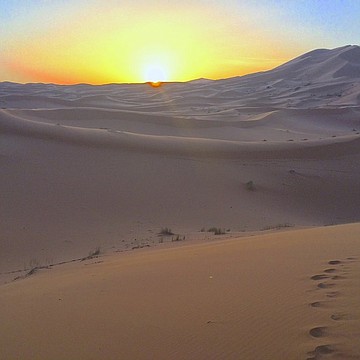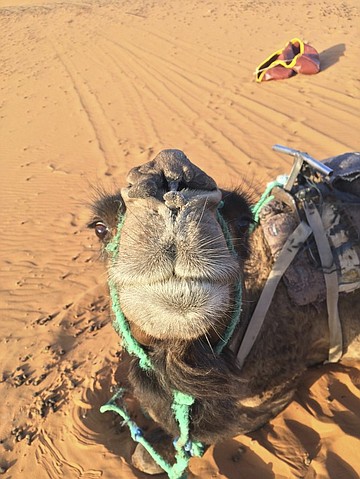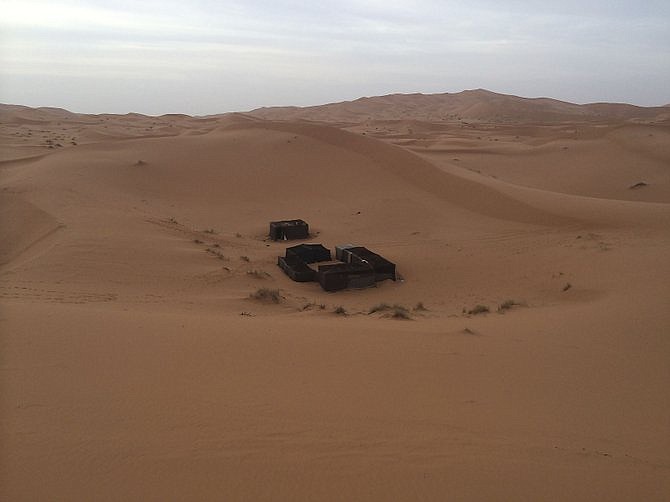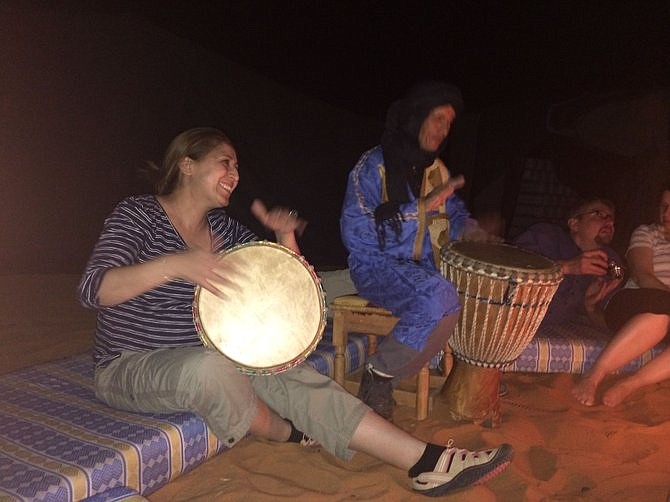 Facebook
Facebook
 X
X
 Instagram
Instagram
 TikTok
TikTok
 Youtube
Youtube


Hassi Labied (population: 2,000) is one of the places you go in Morocco if you want to sleep in the Sahara. It's about 30 miles from the Algerian border; and its dunes (Erg Cheggi) are said to be 20,000 years old. Worn down from mountains, their bases are high, enabling some to reach almost 500 feet in height.
Fifty years ago, only the “black desert” (a flat black basalt wasteland reminiscent of the world's biggest parking lot) butted up against the dunes. But sometime around the mid-1960s, the region experienced a drought so terrible that about 60 Berber families decided they could no longer pursue their lives as nomads. They settled here.
The families survived, farming small irrigated plots. But locals say just 15 years ago life was primitive. They believe what turned things around was Hillary Clinton’s decision to visit the dunes with Chelsea around 2000. In anticipation of their arrival, the Moroccan government spiffed up the place, grading the roadbed and installing a telecommunications link.
Although the Clinton women buzzed in and out in just a day, the paved road that runs from the ancient Mahgreb capital of Rissani today brings increasing numbers of other visitors bound for the guesthouses that the locals, in growing numbers, have opened.
It took us about 30 minutes to drive from Rissani in our rented car. Hassi Labied itself is still sketchy (dirt roads, no signs). But the Seggaoui family’s Maison Guesthouse Merzouga ($69 a night) justified the online praise that led me to it. Built of mud mixed with straw, its workmanship looked expert. Each of several huge salons had 20-foot ceilings and WiFi. Huge rugs decorated the walls. L'Hassan, the second-oldest brother and most ebullient of a charismatic family, led us to a terrace with a great view of the dunes, and over mint tea regaled us with stories as we watched the setting sun paint the desert deeper and richer shades.
Pleasant as that was, what had drawn us to this remote place was the chance to ride camels out into the desert for a camp-out.
Late the next afternoon, we drove to a staging area where our camel driver, Omar, helped us and four traveling companions (a family from Brooklyn) onto the piles of blankets that comprise the bulk of camel saddles in this part of the world. Then we set off.

I like the calm that camels exude and how superbly they're adapted to the desert. I love their huge eyes and lashes and the way their mouths often curve into something resembling a smile. I enjoyed the gentle back and forth motion as we departed the village. But then the animals’ pace quickened, and the ride began to feel more like being on a rocking horse on crack.
To keep from falling off, I gripped the metal bar at the front of my “saddle.” After less than an hour, my hands were cramping from the effort, and my lower back was informing me it would make its displeasure known later.
Still, the glories of the scenery made the discomforts fade. The sands of Erg Cheggi are a beautiful peachy tan. In the warm light of the sinking sun, the landscape reminded me of flawless naked flesh, smooth and sensual. Some patches were pristine; others sprouted patches of dried grass or sprinklings of camel droppings (which look like dessicated meatballs.) It's strange and rare to be anywhere in the world today with no sharp angles. But this place was all long curving arcs and soft bends.

We reached the guesthouse's bivouac site before 6, and in the fading twilight, we climbed to some of the nearby heights. Our 9-year-old traveling companion scrambled up the slopes and tried to slide down on a piece of plastic. Then we all adjourned to the tent compound to drink mint tea and talk and eat tagines and orange slices dusted with cinnamon.

My husband and I had our own capacious tent, which held a comfortable foam mattress. We slept well, waking before dawn to hike to a high point where we could catch the dawn. The wind was blowing hard enough to erase our footprints after just a few minutes but not so hard as to mar the beauty of the morning. Once the sun was up, we packed, climbed onto the camels again, and rode back to the village.
We showered at the guesthouse, ate breakfast, loaded the car, and drove north toward Fes through a landscape that often vied with some of the most dramatic parts of the American West. We were far more comfortable than we’d been on the camels. But it’s the austere landscape and joint-wracking ride that we won't forget.



Hassi Labied (population: 2,000) is one of the places you go in Morocco if you want to sleep in the Sahara. It's about 30 miles from the Algerian border; and its dunes (Erg Cheggi) are said to be 20,000 years old. Worn down from mountains, their bases are high, enabling some to reach almost 500 feet in height.
Fifty years ago, only the “black desert” (a flat black basalt wasteland reminiscent of the world's biggest parking lot) butted up against the dunes. But sometime around the mid-1960s, the region experienced a drought so terrible that about 60 Berber families decided they could no longer pursue their lives as nomads. They settled here.
The families survived, farming small irrigated plots. But locals say just 15 years ago life was primitive. They believe what turned things around was Hillary Clinton’s decision to visit the dunes with Chelsea around 2000. In anticipation of their arrival, the Moroccan government spiffed up the place, grading the roadbed and installing a telecommunications link.
Although the Clinton women buzzed in and out in just a day, the paved road that runs from the ancient Mahgreb capital of Rissani today brings increasing numbers of other visitors bound for the guesthouses that the locals, in growing numbers, have opened.
It took us about 30 minutes to drive from Rissani in our rented car. Hassi Labied itself is still sketchy (dirt roads, no signs). But the Seggaoui family’s Maison Guesthouse Merzouga ($69 a night) justified the online praise that led me to it. Built of mud mixed with straw, its workmanship looked expert. Each of several huge salons had 20-foot ceilings and WiFi. Huge rugs decorated the walls. L'Hassan, the second-oldest brother and most ebullient of a charismatic family, led us to a terrace with a great view of the dunes, and over mint tea regaled us with stories as we watched the setting sun paint the desert deeper and richer shades.
Pleasant as that was, what had drawn us to this remote place was the chance to ride camels out into the desert for a camp-out.
Late the next afternoon, we drove to a staging area where our camel driver, Omar, helped us and four traveling companions (a family from Brooklyn) onto the piles of blankets that comprise the bulk of camel saddles in this part of the world. Then we set off.

I like the calm that camels exude and how superbly they're adapted to the desert. I love their huge eyes and lashes and the way their mouths often curve into something resembling a smile. I enjoyed the gentle back and forth motion as we departed the village. But then the animals’ pace quickened, and the ride began to feel more like being on a rocking horse on crack.
To keep from falling off, I gripped the metal bar at the front of my “saddle.” After less than an hour, my hands were cramping from the effort, and my lower back was informing me it would make its displeasure known later.
Still, the glories of the scenery made the discomforts fade. The sands of Erg Cheggi are a beautiful peachy tan. In the warm light of the sinking sun, the landscape reminded me of flawless naked flesh, smooth and sensual. Some patches were pristine; others sprouted patches of dried grass or sprinklings of camel droppings (which look like dessicated meatballs.) It's strange and rare to be anywhere in the world today with no sharp angles. But this place was all long curving arcs and soft bends.

We reached the guesthouse's bivouac site before 6, and in the fading twilight, we climbed to some of the nearby heights. Our 9-year-old traveling companion scrambled up the slopes and tried to slide down on a piece of plastic. Then we all adjourned to the tent compound to drink mint tea and talk and eat tagines and orange slices dusted with cinnamon.

My husband and I had our own capacious tent, which held a comfortable foam mattress. We slept well, waking before dawn to hike to a high point where we could catch the dawn. The wind was blowing hard enough to erase our footprints after just a few minutes but not so hard as to mar the beauty of the morning. Once the sun was up, we packed, climbed onto the camels again, and rode back to the village.
We showered at the guesthouse, ate breakfast, loaded the car, and drove north toward Fes through a landscape that often vied with some of the most dramatic parts of the American West. We were far more comfortable than we’d been on the camels. But it’s the austere landscape and joint-wracking ride that we won't forget.
Comments